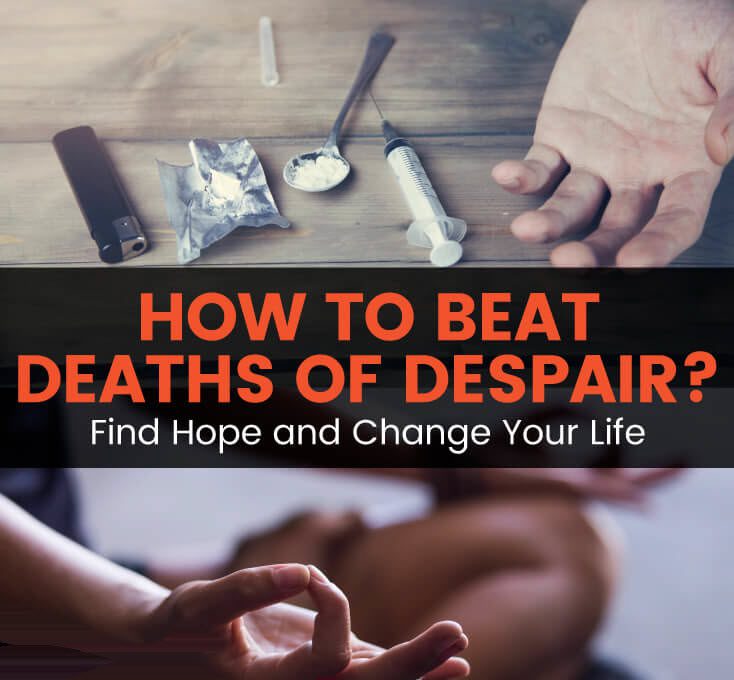
How to Beat Deaths of Despair
Recent research seems to suggest that there are two Americas. There’s the one where those with college degrees thrive.
Then there’s the one where those without a college education struggle.
A team of researchers at Princeton University recently published “Mortality and Morbidity in the 21st Century”.
This research is a follow up to their essential 2015 study, “Rising Morbidity and Mortality in Midlife Among White Non-Hispanic Americans in the 21st Century.”
Professors Anne Case and Angus Deaton noted there had been an increase in mortality rates since the late 1990s among middle-aged non-Hispanic whites with a high school diploma or less.
This increase occurs while mortality rates continue to decline among all classes in “most of the rich world.”
They have attributed this increase in mortality to what they call “deaths of despair.” What does that mean exactly?
And more importantly, how can this troubling trend be reversed and lower mortality rates for this demographic?
Deaths of Despair Study
Case and Deaton have found that this increase in mortality is due not only to the common diseases of middle age, heart disease, and cancer but also to a rise in the number of deaths of despair.
These are deaths resulting from drugs, alcohol, and suicide.
These deaths of despair are rising among both men and women without a high school diploma.
They have increased in various areas of the country, regardless of urbanization.
Mortality rates of whites with no more than a high school degree were about 30 percent lower than the mortality rates of blacks in 1999.
They have now grown to 30 percent higher than blacks as of 2015.
The states with the highest morbidity rates are scattered.
They have shifted from being primarily located in the southwest in 2000 to Appalachia, Florida, and the west coast as of the mid-2000s.
Causes of death such as diabetes and respiratory disease aren’t increasing, but they aren’t declining.
Higher rates of drug abuse, alcoholism, and more people getting sick, but not getting better, along with lower economic opportunity, was particularly prevalent in seven southern states: West Virginia, Mississippi, Oklahoma, Tennessee, Kentucky, Alabama, and Arkansas.
Deaths of Despair Conclusions
Case and Deaton state that “measurable deterioration in economic and social wellbeing” accompanies this rise in the rate of despair.
Working-class jobs reached a high in the early 1970s. They were seen as a sure-fire way for families to move up the socioeconomic ladder and build a middle-class lifestyle.
The downturn from this “heyday” has continued through the 2008 Great Recession and its long recovery.
The elimination of these jobs has occurred along with a skyrocketing rate of suicide, drug overdoses, and diseases attributed to drug and alcohol use.
The rise in opioid addiction is attributable to some of these deaths.
However, Case and Deaton suggest that the high rates of drug abuse may indicate the broader epidemic of deaths of despair.

How to Change Despair into Hope
Statistics like these can seem daunting. But these deaths of despair don’t have to continue.
If you’re in a similar situation where job prospects seem low, and health concerns are deep, have hope. You can take steps to improve your situation, one step at a time.
It’s essential to figure out your goals and do a little planning. There may be resources in your area that can help you get your footing on a new future.
It’s also helpful to find healthy ways to manage stress so that you can move forward with reaching your goals.
This holistic approach includes finding physical, mental, emotional, and spiritual balance in your life.
STEP ONE: Set Goals and Plan Your New Future
1. Goal setting: First, figure out what your needs are and what you want to achieve.
If you are looking for a new job, you may want to start by listing some possible employers, for example.
Maybe you need new job skills. Or, perhaps you want to take some classes to prepare you for the GED or other educational goals.
Taking some time to sit down and do some goal setting can go a long way toward figuring out the steps you need to take to reach your goals.
Make sure your goals are clearly defined and measurable and that you set dates to reach them.
You may be surprised at how effective taking these simple steps can be toward achieving success.
2. GED: Part of your goal setting may include further education.
If you didn’t complete high school, it’s well worth considering attending a general education development (GED) preparation program.
Completing your GED can open doors for you.
This is true whether it means further education, such as a job training program or college, or getting started in a new job with more prospects.
On top of additional opportunities, finishing your high school education can improve your health.
3. Job training: Maybe you already have your high school diploma or GED, but you’d like to build some new job skills.
STEP TWO: Focus on Your Mental and Emotional Wellbeing
Losing a job, health challenges, and making significant life changes can be stressful. You may feel like you’re on an emotional roller coaster.
While you’re working on the next steps, it’s essential to manage your stress and anxiety.
There are many healthy ways to deal with stress. You might want to try keeping a journal to process your thoughts.
Some people find being in nature or spending time with friends helps take their mind off their problems and provides some needed emotional relief.
If you are struggling with alcohol or drug addiction, seek professional help from your healthcare provider or a rehabilitation program.
1. Meditation and prayer: For thousands of years, meditation and healing prayer have been used as stress relievers.
They are also known to improve wellbeing. Just a few minutes a day spent in prayer, mindful contemplation, or guided meditation can lower physiological responses to stress.
2. CBT: If your stress level is becoming unmanageable, you might find that cognitive-behavioral therapy (CBT) will help you challenge and reframe your thoughts more positively and productively.
CBT can help you better manage anxiety and depression and face your problems assertively.
You can try these methods on your own. You may find that they are more successful under the supervision of a therapist.
3. Natural remedies for depression: If you are struggling with mild depression, there are also natural remedies you can try to manage depression.
These can include dietary changes, such as cutting alcohol and sugar and adding helpful vitamins and supplements to your diet, such as a B-complex vitamin or St. John’s Wort.
This is an herb that can help improve mild to moderate depression.
If these remedies don’t seem to help, or your anxiety and depression is severe, see a mental health specialist for further guidance.
If you or someone you love is experiencing suicidal thoughts or life seems hopeless, call the National Suicide Prevention Lifeline at 1-800-273-8255.
STEP THREE: Improve Your Physical Health
Aside from your mental and emotional health, it’s also essential to maintain your physical health.
This is true in general, but especially when you’re facing significant life challenges. Physical exercise can boost happiness levels,
improve memory, increase self-confidence, and improve performance at work or school, among other benefits.
Goal setting is essential for exercise, too. For example, you may want to lose a certain number of pounds.
If you are able, you could try a task as simple as walking to lose weight a few days a week to reach your goal.
Check with your healthcare provider before making significant dietary or exercise changes.
In addition to physical exercise, eating a healthy diet can do wonders to improve not only your physical health but also your mental and emotional health.
To get started on improving your diet, check out my healing diet.
It includes guidance on foods to eat to help manage or beat diseases like diabetes, heart disease, autism, digestive disorders, fatigue, depression, hormonal imbalance, and cancer prevention.
Final Thoughts
If you’re one of the many people dealing with fewer job prospects and accompanying health problems.
You can make holistic lifestyle changes to improve your health and find a new job and a new future.
Be sure to check with your healthcare provider before making significant dietary or exercise changes.
If you suffer from severe anxiety, depression, or suicidal thoughts, reach out to your healthcare provider or a mental health specialist.







